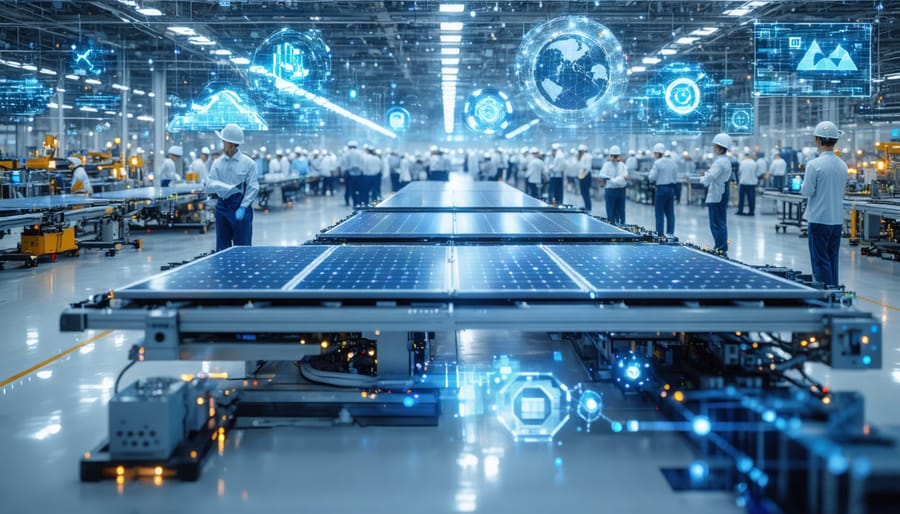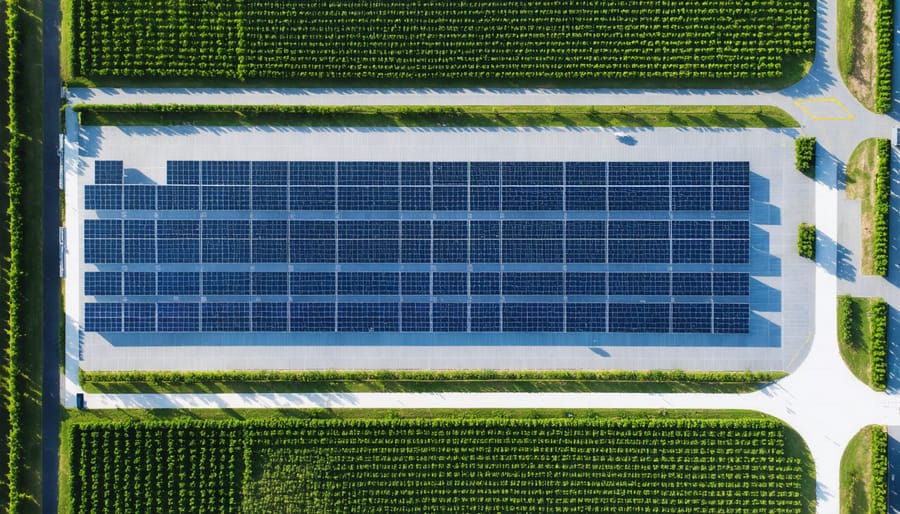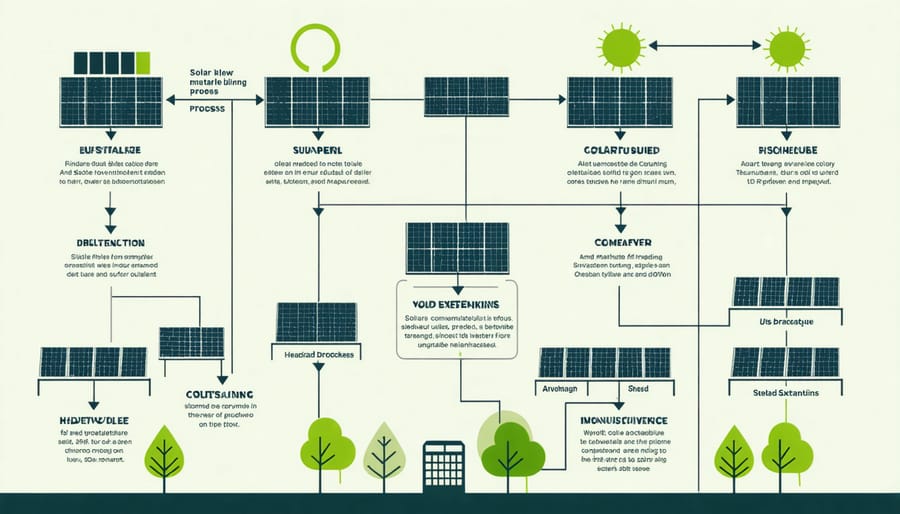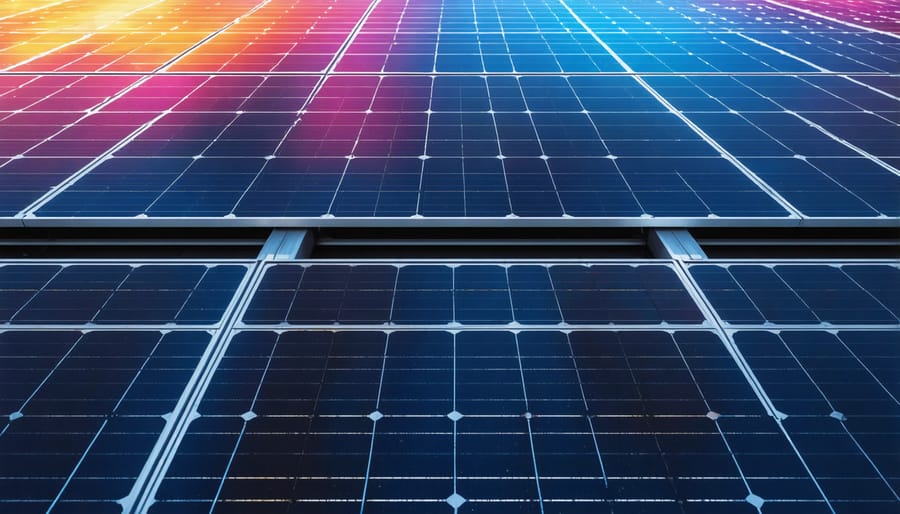U.S. Solar Manufacturing Surge: Building Tomorrow’s Clean Energy Today

The United States stands at a pivotal moment in its solar manufacturing trajectory, with production capacity surging to unprecedented levels amid global supply chain shifts and ambitious climate goals. In 2023, domestic solar manufacturing witnessed a remarkable transformation, as investments exceeding $6 billion poured into new facilities across the nation. The Inflation Reduction Act’s manufacturing incentives have catalyzed a renaissance in American solar production, promising to triple current capacity by 2025.
This manufacturing expansion represents more than just numbers – it’s reshaping the global solar landscape, with significant implications for European markets and international trade dynamics. From polysilicon production in Washington state to module assembly in Georgia, the U.S. is rapidly building a robust, end-to-end solar supply chain that emphasizes sustainability and innovation.
New facilities incorporating state-of-the-art automation and energy-efficient processes are setting global benchmarks for sustainable manufacturing. These developments not only strengthen America’s energy independence but also offer European businesses new opportunities for transatlantic partnerships and technology exchange. As global demand for solar solutions continues to soar, U.S. manufacturing capacity is positioning itself as a crucial pillar in the worldwide transition to renewable energy.
Current U.S. Solar Manufacturing Landscape

Manufacturing Capacity Statistics
The United States has significantly expanded its solar manufacturing capacity in recent years, with current production reaching approximately 8.5 GW of solar modules annually. Major manufacturing hubs are strategically distributed across multiple states, with notable concentrations in California, Texas, Ohio, and Georgia. These facilities collectively employ over 30,000 workers in various production roles.
Leading manufacturers have established state-of-the-art facilities, with First Solar’s Ohio plant standing out as one of the largest, capable of producing 3.3 GW of thin-film modules annually. The domestic market share has grown to approximately 20% of U.S. solar installations, marking a substantial increase from previous years.
In terms of technology distribution, crystalline silicon module production accounts for roughly 70% of domestic manufacturing capacity, while thin-film technology makes up the remaining 30%. The industry has also seen significant investment in wafer and cell production, with new facilities under construction expected to add 5 GW of additional capacity by 2024.
Recent developments include the establishment of integrated manufacturing complexes that combine multiple production steps, from polysilicon processing to final module assembly. These facilities particularly benefit from advanced automation and quality control systems, ensuring high production standards while maintaining competitive pricing structures that appeal to both domestic and international markets.
Recent Industry Expansions
The U.S. solar manufacturing landscape has witnessed remarkable growth in recent years, with several major investments reshaping the industry. In 2023, First Solar announced a $1.1 billion facility in Alabama, projected to generate 3.5 GW of solar modules annually. This expansion adds to their existing operations and reinforces America’s position in sustainable energy production.
Georgia has emerged as a significant hub, with Q CELLS investing $2.5 billion to establish the largest solar panel manufacturing complex in the Western hemisphere. This facility aims to produce 8.4 GW of solar components annually by 2024, creating over 2,500 jobs and strengthening the domestic supply chain.
Meyer Burger’s expansion into Colorado marks another milestone, with their 2 GW facility representing substantial European investment in U.S. solar capabilities. The project demonstrates growing international confidence in American manufacturing potential and creates valuable transatlantic partnerships.
Recent projections suggest U.S. solar manufacturing capacity could triple by 2025, driven by incentives from the Inflation Reduction Act. This growth extends beyond panel production to include essential components like inverters and mounting systems. Companies like Nextracker and Array Technologies have announced new facilities focused on tracker systems, while several manufacturers are developing advanced cell technology production lines, positioning the U.S. as a leader in solar innovation.
Sustainable Manufacturing Practices in U.S. Solar Production

Energy-Efficient Production Methods
U.S. solar manufacturers are increasingly adopting innovative technologies to reduce their solar manufacturing carbon footprint while maintaining high-quality production standards. Advanced automation systems and smart factory technologies have enabled manufacturers to optimize energy consumption throughout the production process, resulting in up to 40% reduction in energy usage compared to traditional methods.
Key innovations include the implementation of heat recovery systems that capture and reuse thermal energy from production processes, particularly during the energy-intensive silicon wafer manufacturing stage. Many facilities have also transitioned to renewable energy sources for their operations, with several major manufacturers powering their facilities entirely through solar and wind energy.
Water conservation technologies have become paramount, with closed-loop water recycling systems reducing consumption by up to 90% in some facilities. Advanced filtration and purification systems ensure that recycled water meets the stringent requirements for solar cell production while minimizing environmental impact.
The integration of artificial intelligence and machine learning has further enhanced production efficiency, optimizing resource allocation and reducing waste. Smart sensors and real-time monitoring systems ensure precise control over manufacturing parameters, resulting in higher yields and lower energy consumption per unit produced.
Materials innovation has also played a crucial role, with manufacturers developing processes that require lower firing temperatures and faster processing times. These improvements not only reduce energy consumption but also increase production throughput, making sustainable manufacturing more economically viable while maintaining the high quality standards expected by European markets.
Material Recycling and Waste Reduction
The U.S. solar manufacturing sector is increasingly embracing circular economy principles to address environmental concerns and resource efficiency. Manufacturers are implementing innovative recycling programs for critical solar panel materials, including silicon, glass, and precious metals, significantly reducing waste and environmental impact.
Modern facilities employ advanced material recovery processes that can reclaim up to 95% of semiconductor materials and 90% of glass from end-of-life panels. These recovered materials are then reintegrated into new production cycles, reducing reliance on raw material extraction and minimizing manufacturing costs.
Several leading U.S. manufacturers have established take-back programs, partnering with European recycling facilities to ensure proper handling of decommissioned panels. This cross-continental collaboration strengthens the global circular economy while meeting strict EU waste management standards.
Waste reduction initiatives extend beyond recycling, with manufacturers implementing lean production techniques and automated quality control systems. These innovations have resulted in significant decreases in material waste during production, with some facilities reporting up to 30% reduction in manufacturing scrap.
The industry is also investing in design-for-recycling approaches, developing new panel architectures that facilitate easier disassembly and material recovery at end-of-life. This forward-thinking strategy aligns with both U.S. and European sustainability goals while ensuring long-term resource availability for continued industry growth.
These circular economy practices not only benefit the environment but also enhance the sector’s economic sustainability, creating new job opportunities in recycling and material recovery while reducing production costs through resource optimization.
Policy Impact and Industry Support
Federal and State Incentives
The United States has implemented robust incentive programs to boost domestic solar manufacturing capacity, with the Inflation Reduction Act (IRA) of 2022 serving as a cornerstone policy. This landmark legislation provides substantial tax credits for manufacturers, including up to 40% credit for the production of solar panels and key components like cells, wafers, and polysilicon.
State-level initiatives complement federal support, with various regions offering unique incentives. California leads with its Solar Energy Manufacturing Program, while states like Georgia and Texas provide tax exemptions and workforce development grants. These combined federal and state measures have already attracted over $100 billion in manufacturing investments.
The Manufacturing Production Tax Credit particularly impacts the solar supply chain, offering specific benefits for each component: $0.07/W for modules, $0.04/W for cells, and $12/m² for wafers. Additional incentives target raw material production and specialized equipment manufacturing.
For European businesses, these incentives present opportunities for strategic partnerships and market expansion. The programs often include provisions for international collaboration, allowing European companies to participate in the growing U.S. solar manufacturing ecosystem through joint ventures and technology transfers. This framework has created a stable, long-term environment for sustainable manufacturing growth while fostering global industry connections.
Industry Partnerships and Innovation
The U.S. solar manufacturing sector thrives on robust partnerships between industry leaders, research institutions, and government agencies. The National Renewable Energy Laboratory (NREL) plays a pivotal role by connecting manufacturers with cutting-edge research and development opportunities. These collaborations have led to significant breakthroughs in solar cell efficiency and cost reduction.
Major universities contribute through specialized research centers, where industry professionals work alongside academic experts to develop next-generation solar technologies. The Solar Energy Manufacturing for America Coalition exemplifies this collaborative spirit, bringing together manufacturers, suppliers, and researchers to strengthen domestic supply chains and accelerate innovation.
The Department of Energy’s Solar Energy Technologies Office facilitates public-private partnerships through initiatives like the American-Made Challenges, which incentivize breakthrough solutions in solar manufacturing. These programs have resulted in numerous patents and commercially viable technologies that enhance U.S. manufacturing capabilities.
State-level innovation hubs, particularly in California, Texas, and New York, create regional ecosystems where manufacturers can access specialized expertise, testing facilities, and workforce development programs. These partnerships have proven instrumental in scaling up production capacity and improving manufacturing processes.
European companies increasingly participate in these collaborative networks, contributing expertise in advanced manufacturing techniques and sustainable production methods. This international knowledge exchange strengthens both U.S. manufacturing capabilities and global solar industry standards.

Future Outlook and Market Projections
The U.S. solar manufacturing sector stands at the cusp of significant expansion, with projections indicating a substantial increase in domestic production capacity over the next decade. Industry analysts forecast that U.S. solar manufacturing could triple by 2025, driven by recent policy initiatives and growing market demand. The implementation of innovative manufacturing cost reduction strategies is expected to play a crucial role in this growth trajectory.
Key growth drivers include the Inflation Reduction Act’s manufacturing incentives, increasing corporate commitments to renewable energy, and rising consumer demand for domestically produced solar components. Market projections suggest that U.S. manufacturing capacity could reach 50 GW annually by 2030, positioning the country as a major global producer of solar technology.
However, this growth path faces several challenges. Supply chain dependencies, particularly for raw materials and specialized components, remain a concern. Competition from established manufacturing hubs in Asia continues to influence market dynamics, while workforce development needs careful attention to meet the industry’s expanding requirements.
Despite these challenges, opportunities abound. The development of advanced manufacturing facilities, integration of automation technologies, and focus on high-efficiency solar products present significant potential for industry advancement. European businesses and investors are increasingly viewing U.S. solar manufacturing capabilities as a strategic partner in their sustainability initiatives.
The sector’s future outlook is particularly promising for innovation in sustainable manufacturing processes. Industry leaders are investing in circular economy principles, developing recycling capabilities, and implementing energy-efficient production methods. These developments align well with European environmental standards and sustainability goals.
For European stakeholders, this growth presents opportunities for technology transfer, joint ventures, and market expansion. The strengthening of U.S. manufacturing capabilities could lead to more stable global supply chains and increased options for sourcing high-quality solar components, benefiting both markets.
The U.S. solar manufacturing landscape is undergoing a remarkable transformation, positioning itself as a significant player in the global renewable energy market. The substantial investments in manufacturing capacity, coupled with supportive policy frameworks like the Inflation Reduction Act, have created a robust foundation for sustained growth. This expansion not only strengthens America’s energy independence but also presents valuable opportunities for European businesses and investors seeking reliable supply chain partnerships.
Current trends indicate that U.S. solar manufacturing capacity could triple by 2025, driven by technological innovations and increased automation in production processes. This growth trajectory suggests enhanced cost competitiveness and improved product quality, benefiting both domestic and international markets. The focus on sustainable manufacturing practices and circular economy principles further strengthens the industry’s long-term viability.
For European stakeholders, this evolution in U.S. solar manufacturing capacity represents a strategic opportunity to diversify supply chains and access high-quality solar components. The emphasis on innovation and sustainability aligns well with European environmental standards and energy transition goals. As the industry continues to mature, we can expect closer transatlantic collaboration, knowledge sharing, and trade relationships that will accelerate the global adoption of solar energy solutions.
Looking ahead, the U.S. solar manufacturing sector is well-positioned to play a pivotal role in advancing renewable energy technologies and supporting international climate objectives.
Leave a Reply